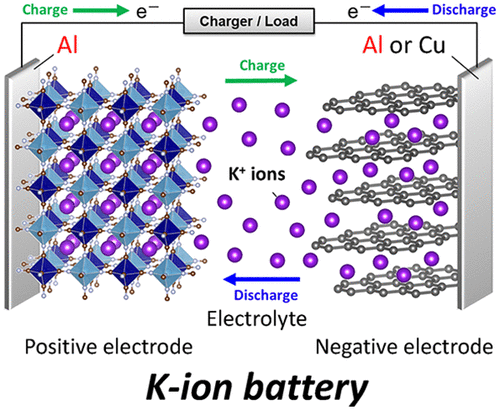当前位置:
X-MOL 学术
›
Chem. Rev.
›
论文详情
Our official English website, www.x-mol.net, welcomes your feedback! (Note: you will need to create a separate account there.)
Research Development on K-Ion Batteries.
Chemical Reviews ( IF 62.1 ) Pub Date : 2020-01-15 , DOI: 10.1021/acs.chemrev.9b00463 Tomooki Hosaka 1 , Kei Kubota 1, 2 , A Shahul Hameed 1, 2 , Shinichi Komaba 1, 2
Chemical Reviews ( IF 62.1 ) Pub Date : 2020-01-15 , DOI: 10.1021/acs.chemrev.9b00463 Tomooki Hosaka 1 , Kei Kubota 1, 2 , A Shahul Hameed 1, 2 , Shinichi Komaba 1, 2
Affiliation

|
Li-ion batteries (LIBs), commercialized in 1991, have the highest energy density among practical secondary batteries and are widely utilized in electronics, electric vehicles, and even stationary energy storage systems. Along with the expansion of their demand and application, concern about the resources of Li and Co is growing. Therefore, secondary batteries composed of earth-abundant elements are desired to complement LIBs. In recent years, K-ion batteries (KIBs) have attracted significant attention as potential alternatives to LIBs. Previous studies have developed positive and negative electrode materials for KIBs and demonstrated several unique advantages of KIBs over LIBs and Na-ion batteries (NIBs). Thus, besides being free from any scarce/toxic elements, the low standard electrode potentials of K/K+ electrodes lead to high operation voltages competitive to those observed in LIBs. Moreover, K+ ions exhibit faster ionic diffusion in electrolytes due to weaker interaction with solvents and anions than that of Li+ ions; this is essential to realize high-power KIBs. This review comprehensively covers the studies on electrochemical materials for KIBs, including electrode and electrolyte materials and a discussion on recent achievements and remaining/emerging issues. The review also includes insights into electrode reactions and solid-state ionics and nonaqueous solution chemistry as well as perspectives on the research-based development of KIBs compared to those of LIBs and NIBs.
中文翻译:

钾离子电池的研究开发。
锂离子电池(LIB)于1991年商业化,在实用的二次电池中具有最高的能量密度,并广泛用于电子,电动汽车,甚至固定式储能系统中。随着需求和应用范围的扩大,人们对Li和Co的资源越来越关注。因此,需要由富含稀土元素的二次电池来补充LIB。近年来,作为LIB的潜在替代品,K离子电池(KIB)受到了广泛的关注。先前的研究已经开发出用于KIB的正极和负极材料,并证明了KIB优于LIB和Na-ion电池(NIB)的几个独特优势。因此,除了不含任何稀有/有毒元素外,K / K +的低标准电极电势电极导致的高工作电压与LIB中观察到的电压相当。此外,由于与溶剂和阴离子的相互作用比与Li +离子弱,因此K +离子在电解质中的离子扩散更快。这对于实现大功率KIB至关重要。这篇综述全面涵盖了用于KIB的电化学材料的研究,包括电极和电解质材料,并讨论了最近的成就和剩余/新兴问题。综述还包括对电极反应,固态离子和非水溶液化学的见解,以及与LIB和NIB相比,基于研究的KIBs的发展前景。
更新日期:2020-01-15
中文翻译:

钾离子电池的研究开发。
锂离子电池(LIB)于1991年商业化,在实用的二次电池中具有最高的能量密度,并广泛用于电子,电动汽车,甚至固定式储能系统中。随着需求和应用范围的扩大,人们对Li和Co的资源越来越关注。因此,需要由富含稀土元素的二次电池来补充LIB。近年来,作为LIB的潜在替代品,K离子电池(KIB)受到了广泛的关注。先前的研究已经开发出用于KIB的正极和负极材料,并证明了KIB优于LIB和Na-ion电池(NIB)的几个独特优势。因此,除了不含任何稀有/有毒元素外,K / K +的低标准电极电势电极导致的高工作电压与LIB中观察到的电压相当。此外,由于与溶剂和阴离子的相互作用比与Li +离子弱,因此K +离子在电解质中的离子扩散更快。这对于实现大功率KIB至关重要。这篇综述全面涵盖了用于KIB的电化学材料的研究,包括电极和电解质材料,并讨论了最近的成就和剩余/新兴问题。综述还包括对电极反应,固态离子和非水溶液化学的见解,以及与LIB和NIB相比,基于研究的KIBs的发展前景。



























 京公网安备 11010802027423号
京公网安备 11010802027423号